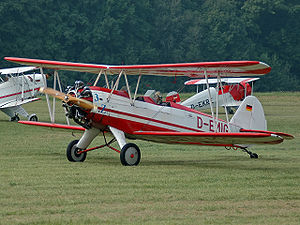Focke-Wulf Fw 44
| Fw 44 Stieglitz | |
|---|---|
 |
|
| A Focke-Wulf Fw 44J in 2005. | |
| Role | biplane trainer |
| National origin | Germany |
| Manufacturer |
Focke-Wulf FMA |
| First flight | Late summer 1932 |
The Focke-Wulf Fw 44 is a 1930s German two-seat biplane known as the Stieglitz ("Goldfinch"). It was produced by the Focke-Wulf company as a pilot training and sport flying aircraft. It was also eventually built under license in several other countries.
The Fw 44 was designed as a biplane with conventional layout and straight, untapered wings. Its two open cockpits were arranged in tandem, and both cockpits were equipped with flight controls and instruments. The Fw 44 had fixed tailwheel landing gear. It employed ailerons on both upper and lower wings. It did not use flaps. It was flown with a Siemens-Halske Sh 14 radial engine.
The first prototype flew in 1932. After many tests and modifications to increase the plane's durability and aerodynamics, the final Fw 44 proved to have excellent airworthiness.
A second version of the Fw 44 was the Fw 44B, which had an Argus As 8 four-cylinder inverted inline air-cooled engine of 90 kW (120 hp). The cowling for this engine gave the plane a more slender, aerodynamic nose.
20 Fw 44s purchased by China were modified for combat missions and participated in the early stage of the Second Sino-Japanese War until all were lost in action.
The last series version was the Fw 44J, which was sold or built under license in several countries around the world. It was equipped with a seven-cylinder Siemens-Halske Sh 14 radial engine.
Data from Holmes, 2005. p. 79.
General characteristics
Performance
...
Wikipedia
